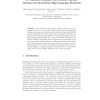Free Online Productivity Tools
i2Speak
i2Symbol
i2OCR
iTex2Img
iWeb2Print
iWeb2Shot
i2Type
iPdf2Split
iPdf2Merge
i2Bopomofo
i2Arabic
i2Style
i2Image
i2PDF
iLatex2Rtf
Sci2ools
IVA
2009
Springer
2009
Springer
A Combined Semantic and Motion Capture Database for Real-Time Sign Language Synthesis
Over the past decade, motion capture data has become a popular research tool, and motion databases have grown exponentially. Indexing, querying, and retrieving data has thus become more difficult, and has necessitated innovative approaches to using these databases. Our aim is to make this approach feasible for virtual agents signing in French Sign Language (LSF), taking into account the semantic information implicitly contained in language data. We thus structure a database in two autonomous units, taking advantage of differing indexing methods within each. This allows us to effectively retrieve captured motions to produce LSF animations. We describe our methods for querying motion in the semantic database, computing transitory segments between concatenated signs, and producing realistic animations of a virtual LSF signer.
| Added | 27 May 2010 |
| Updated | 27 May 2010 |
| Type | Conference |
| Year | 2009 |
| Where | IVA |
| Authors | Charly Awad, Nicolas Courty, Kyle Duarte, Thibaut Le Naour, Sylvie Gibet |
Comments (0)

